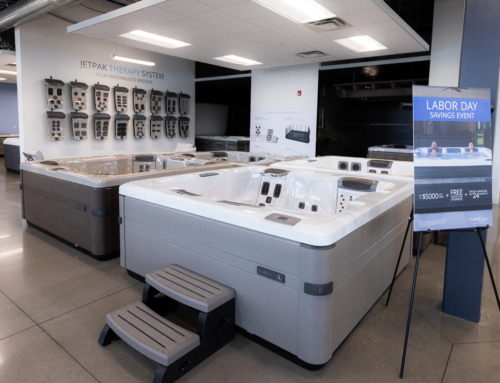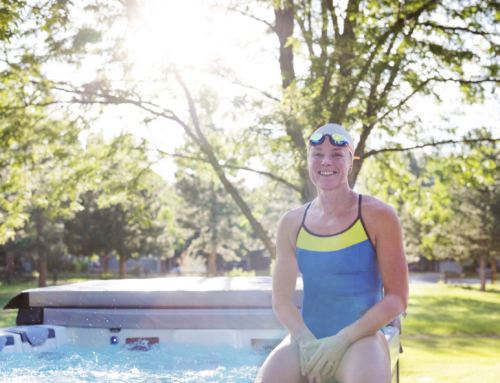Are you thinking about starting your own spa retail business? Here’s a personal account of one prospective dealer describing his consideration process, all the wheres, whats, whos, and hows you need to figure out before opening for business. Your path may vary a bit, but the stepping stones should be close to the same. Hopefully this journey can help you make decisions about yours.
Where Do I Get Started?

photo by: poolspapatio.com
I hadn’t thought much about the spa industry until my brother got a job working for a pool company. Fast forward a few years and I found myself at the Pool and Spa Show in Las Vegas, Nevada. I walked around the show looking at the products and the people who sold them. A question began to form in my mind: What if I opened a spa store?
The “what if” quickly morphed into “but how,” and the next thing I knew, I was making two lists: 1) the things I knew and 2) the things I thought I’d need to know.
I had some idea of what to expect in terms of business registration and licensure since I’d gone through this step before. But there were spa biz specifics I’d need to explore. These included:
- Market Considerations
- The Showroom
- Employee Needs
- Equipment Needs
- Finance Matters
- Product or Brand Selection
Market Considerations
First I decided I needed to determine how realistic the opportunity was, given the market I was considering. Would this market support a new hot tub retailer?
This was a mountain community in the West that currently had two spa dealerships in the immediate area. Since it is a growing mountain community, the market matched one where you would expect to find many likely spa customers: home or property owners ages 40-70 with a degree of affluence who value health and wellness, together time, and/or social status. Plus, there was a ton of development going on that represented healthy market growth.
I decided to visit both local stores to get an idea of what competing with them would look like. I assessed their performance, looking at products and services offered, marketing tactics used, along with what I deemed their strengths and weaknesses. In doing so, I narrowed down some expected key factors for my business’s success. I felt confident that a store done in a certain way, with a strong manufacturer as a partner, could gain its own share of the market.
The Showroom
In addition to the two local competitors, I’d previously been in another spa store outside of my target area. I was struck by the contrast. Where the non-local space had been large, open, and comfortable with some attractive imagery, the spa stores in my market were small and packed with so much product it was difficult to walk around.
That’s when I made my next decision. if I was going to start a spa store, I was going to try to make the space clean and open. I met with a local commercial realtor and asked him to show me available lease options with over 2000 square feet. I looked for locations with good accessibility, visibility, curb appeal, neighboring small businesses that complemented consumer home products, and of course affordability.
Equipment Needs
I had to think about what my retail location would need in terms of selling, delivery fulfillment, and servicing the market. Here’s what I came up with:
- Truck
- Forklift
- Spa dolly
- Shipping trailer
- Shelves
- Point-of-purchase (in-store) display
- Computers
- Point-of-sale technology
- Desks
- Chairs
Employee Needs
Costs associated with employment typically include compensation, benefits, training, taxes, and insurance. In an ideal world, I’d want as few employees as I could get away with in order to contain costs. But there are certain things I wouldn’t be able to do alone. And I reasoned that I may be able to perform more effectively and efficiently with some other hands on deck. I figured I’d need a service person and at least one additional salesperson to cover the showroom and help customers. After looking into it, I found that I could bring on a subcontracting service in the area to deliver and install the spas.
Finance Matters
Next, I did a bit of research to estimate the startup costs mentioned above. I also outlined my fixed expenses—lease, advertising, salaries, insurance, and other overhead—along with my estimated profit margin per unit (selling price less variable costs—wholesale price and commission paid per spa sold).
To calculate the volume I’d need to sell to break even, I just divided the fixed costs by the unit margin. I did this a few times with different profit margins. This helped me understand how performance results would vary according to various pricing scenarios. It also helped estimate how long it would take before I really started making money!
Product or Brand Selection: Picking a Manufacturer
One of the concerns I had about which spas to sell was quality-related—how well these products were constructed and finished. I wanted to make sure the brand or brands I carried were provided by reputable manufacturers who look to the spa dealer as a partner. I also took into account what brands the competition carried.
Each of the leading supplier’s website had a link for information about becoming a dealer. I looked through these specifically for reasons that informed me why I’d want to carry their brand over another. How are their products differentiated? What profit margins would their line offer? What kind of support do they provide around training, financing, inventory tracking, promotions, lead generation, and other marketing programs?
With these issues in mind, I narrowed the list to four potential suppliers: Bullfrog Spas, Sundance, Jacuzzi, and Hot Spring.
Decision Time
The journey for me is not over yet. I’ve gone down the road far enough to have a fair idea of what owning a spa store would look like, but I haven’t pulled the trigger. As with any business, there are risks involved. And I’m still in the process of determining whether the rewards outweigh these risks…for me anyway. I hope my experience helps you get to the same point and if you’ve got any advice I’d love to hear it in the comments to this article.








Nice article